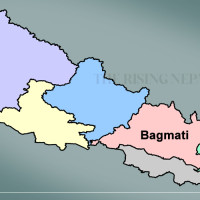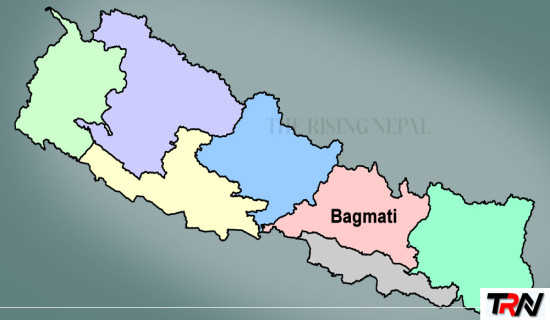- Thursday, 9 May 2024
Is monsoon pattern changing in Nepal?
BY PURUSHOTTAM P. KHATRI, Kathmandu, Oct 16: Like last year, the heavy rains during and after the Dashain festival this year not only spoiled the festive mood of many people but also caused huge losses of life and property, especially in Karnali Province, killing scores of people. Paddy crops ready for harvest were destroyed in the Terai.
It is already mid-October but the monsoon phenomena for this season is yet to formally withdraw from Nepal.
Last year, the monsoon that had entered Nepal on June 11, 2021, retreated only from October 11, 2021, nine days later than the normal date. It lasted for 123 days. The normal onset and withdrawal date of monsoon in Nepal is June 13 and October 2 respectively. On the basis of the normal onset and withdrawal of monsoon, the duration of monsoon is 112 days. The shortest monsoon duration of 73 days was recorded in 1979 and the longest duration of 130 days was recorded in 2008.
The earliest and the latest monsoon onsets were observed on May 31, 1996, and June 27, 1982, respectively. Similarly, the earliest and the latest withdrawals were on September 2, 1995 and October 19, 2013, respectively.
Monsoon, which should normally be over by the first week of October, has been getting delayed in recent years while the monsoon duration has also been extended.
When we compare the meteorological records of the 1970s and 1980s, we find that monsoon rains stopped by at least the second or last week of September. However, over the years, a big change can be seen in the monsoon withdrawal pattern.
In the last one-and-a-half decades, 2012 is the only year when the monsoon withdrew on September 28. In other years, the monsoon rains have stayed longer till the first or the second week of October.
The Climate Division under the DHM has been maintaining meteorological records from 1968. In monsoon history of Nepal, monsoon stayed until October 19 in 2013. When analysing the meteorological data of 1970s collected by the Department of Meteorology and Hydrology (DHM), the monsoon had never lasted until October in the decade.
Leaving some exceptions, from 1980s to 1990s, the monsoon withdrew from the country by the last week of September.
However, since 2006 and afterward, except in 2012, the monsoon had lasted till the second or the third week of October. And all these trends testify the changing character of the monsoon phenomena, according to the meteorologists.
Three years ago, after the change in the monsoon air character, the Department revised the monsoon onset and withdrawal time from the last year, and fixed new average onset time for June 13 and October 2 as withdrawal period. Thus, the duration of monsoon is considered to be 112 days now in Nepal.
“According to the suggestion of the World Meteorological Organisation, the new date is updated every decade by looking at the past trend of three decades, and accordingly the entry and exit dates of the monsoon have been revised since 2020,” Dr. Indira Kandel, senior meteorologist at the DHM, said.
Changing pattern of monsoon rains
During the months of summer, the monsoon brings water from the Indian Ocean and the Bay of Bengal, and it falls as rain in Nepal when it gets intercepted by the Himalayas standing on the north. As the surface of the earth heats up during the summer season in the southern hemisphere, warm air starts to rise. Naturally, the hot air moves upwards as it is lighter.
After that, the air over the ocean, which is relatively cool and moist, moves towards the land to maintain the land pressure. That is why such air flows northwards from the south-west sea towards the Indian subcontinent, which brings rain in Nepal from the second week of June till September.
About 80 per cent of the annual rainfall in Nepal occurs in June, July, August and September.
As the southern hemisphere of the earth begins to cool down, the rain-producing Bay of Bengal winds cease to
flow. Even when the monsoon winds blow from east to west in Nepal, they blow out faster in the west and slower in the east. However, this cloud cannot reach the Tibetan Plateau due to the obstruction created by the Himalayan range. This cycle of weather has been going on for thousands of years, according to Binod Dawadi, Associate Professor of Tribhuvan University under the Department of Hydrology and Meteorology.
However, in recent years, this trend of monsoons has started to change. According to experts, the monsoon is also becoming more difficult to predict now. “In a short period of time, there occurs a lot of rain, uneven rain, and torrential rain in high mountain areas,” Dawadi said.
This year too, at the end of the monsoon period, many districts in the western hill mainly Kalikot, Pyuthan, and Jumla, and Banke and Kailali in the south-west witnessed cloudbursts, which caused heavy rain in one particular place in a short period of time, Dawadi said.
The prolongation of the monsoon has affected the winter crops, and in some regions, the harvesting of paddy has been affected. Monsoon, which was limited to 106 days until a decade ago, has now extended to 120 days, he said.
Senior meteorologist Dr. Kandel said that not only is the withdrawal period of the monsoon getting delayed, but also incidents such as cloudbursts, which cause disasters, are increasing.
According to climate change expert and chairperson at Nepal Water Conservation Foundation for Academy Research, Ngamindra Dahal, it was noticed that the monsoon character has started changing in the Himalayas for the last two decades. “From the last two to three years, we have seen that the monsoon has started affecting life even in the Himalayan districts like Manang, Mustang and Dolpa, where rains used to be rare in the past.” These districts are known as the districts located beyond the Himalayas.
A new kind of dynamism, both predictable and unpredictable, has been seen in the global monsoon phenomena over the years as an effect. The monsoon pattern in the South Asian region, including Nepal, is becoming different and unpredictable every year,” said Dahal.
Review in the monsoon onset and withdrawal time is not the whole thing, but every year the pattern and intensity of monsoon and the damages it may cause have become highly unpredictable, he explained.
He said that the impact of climate change has been seen with the increase in the temperature of the earth and it has been clearly visible in the Himalayan region. “What has been said to happen as a result of climate change has become evident,” he said.
The soil in the Himalayan region cannot withstand much water pressure. Therefore, heavy rain easily washes away the soil there, which could cause more damage in the low-lying coastal settlements, he said.
Though the data of the total rainfall during this monsoon is yet to be confirmed by the DHM, during the monsoon period, about 1,380 mm of rain falls on average. In the year 2021, it rained more than 1,590 mm, 15 per cent more than the average.







-square-thumb.jpg)






